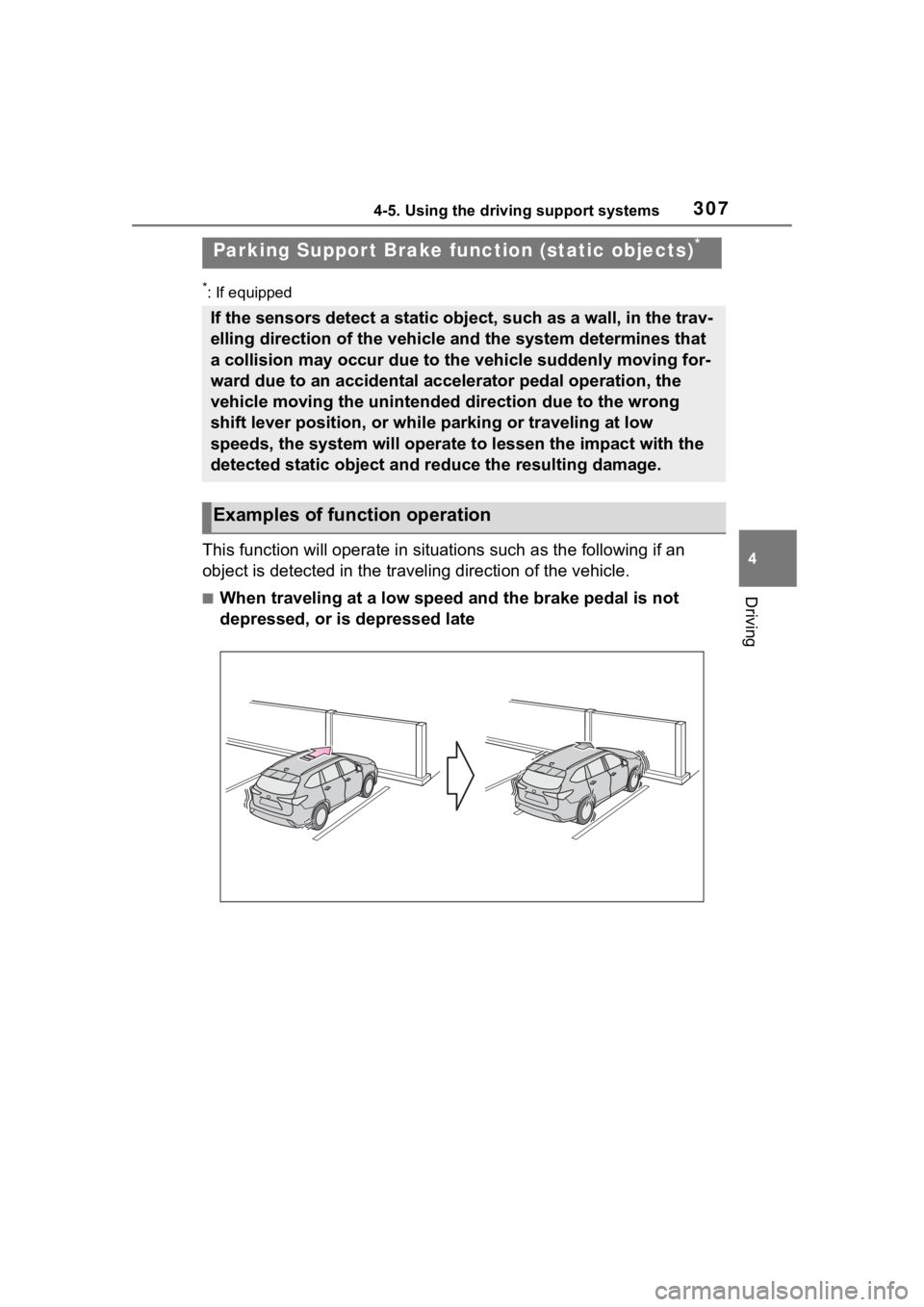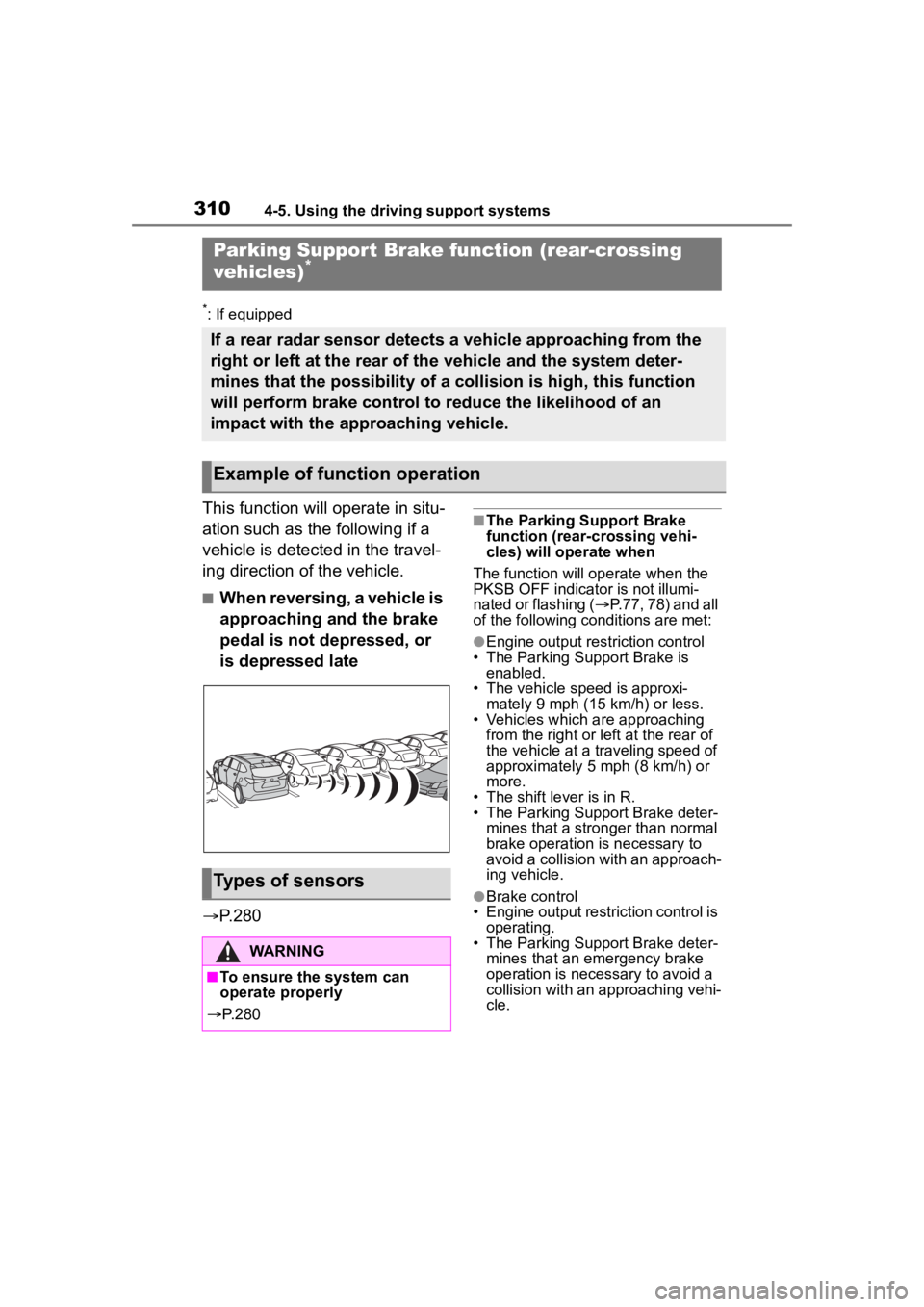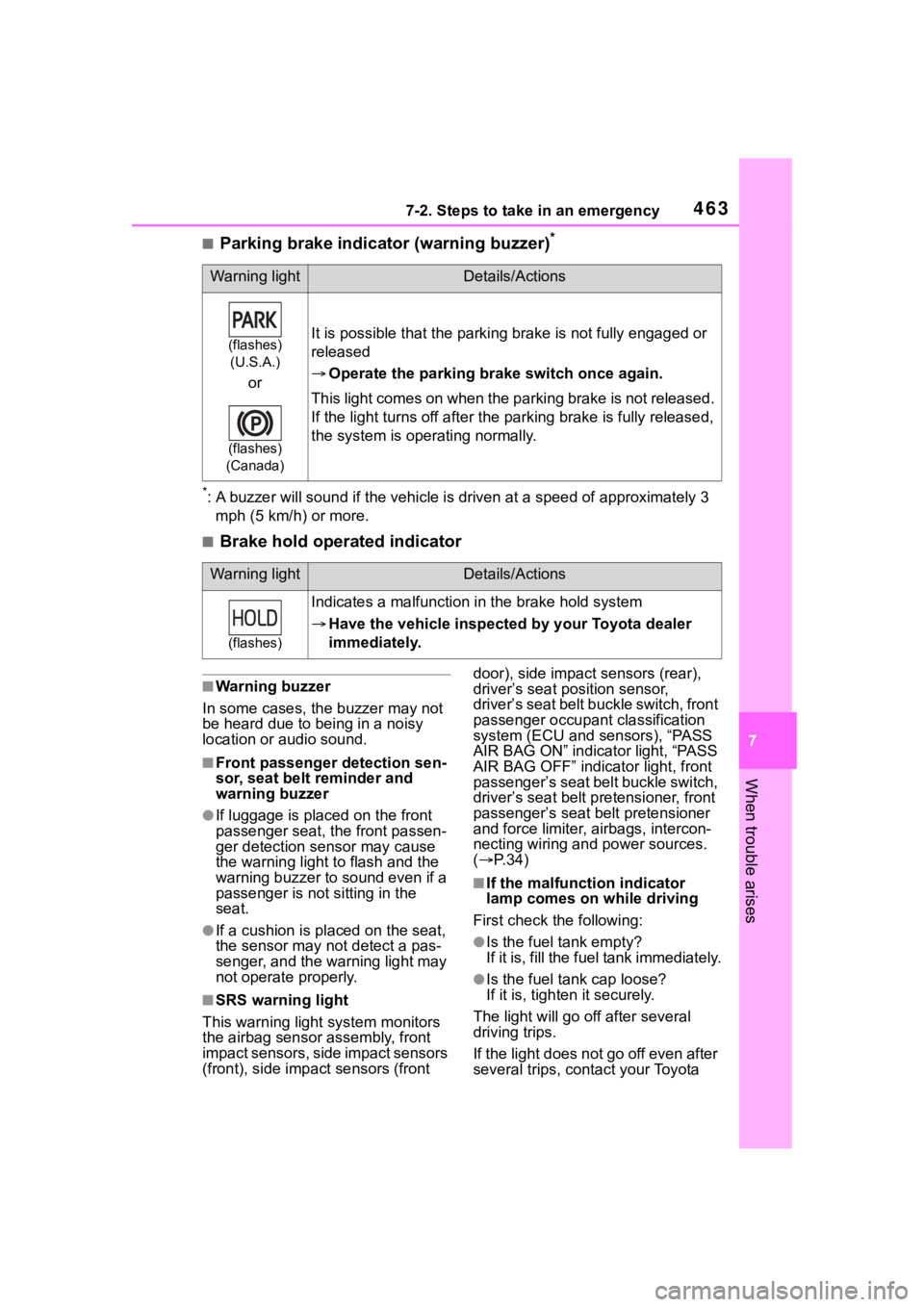parking sensors TOYOTA HIGHLANDER 2022 User Guide
[x] Cancel search | Manufacturer: TOYOTA, Model Year: 2022, Model line: HIGHLANDER, Model: TOYOTA HIGHLANDER 2022Pages: 568, PDF Size: 13.73 MB
Page 307 of 568

3074-5. Using the driving support systems
4
Driving
*: If equipped
This function will operate in situations such as the following if an
object is detected in the traveling direction of the vehicle.
â– When traveling at a low speed and the brake pedal is not
depressed, or is depressed late
Parking Suppor t Brake function (static objects)*
If the sensors detect a static object, such as a wall, in the t rav-
elling direction of the vehicle and the system determines that
a collision may occur due to the vehicle suddenly moving for-
ward due to an accidental accelerator pedal operation, the
vehicle moving the unintended direction due to the wrong
shift lever position, or while parking or traveling at low
speeds, the system will operate to lessen the impact with the
detected static object and reduce the resulting damage.
Examples of function operation
Page 310 of 568

3104-5. Using the driving support systems
*: If equipped
This function will operate in situ-
ation such as the following if a
vehicle is detected in the travel-
ing direction of the vehicle.
â– When reversing, a vehicle is
approaching and the brake
pedal is not depressed, or
is depressed late
ď‚® P.280
â– The Parking Support Brake
function (rear-crossing vehi-
cles) will operate when
The function will op erate when the
PKSB OFF indicator is not illumi-
nated or flashing ( ď‚®P.77, 78) and all
of the following conditions are met:
â—ŹEngine output restriction control
• The Parking Support Brake is enabled.
• The vehicle speed is approxi-
mately 9 mph (15 km/h) or less.
• Vehicles which are approaching from the right or left at the rear of
the vehicle at a traveling speed of
approximately 5 mph (8 km/h) or
more.
• The shift lever is in R.
• The Parking Support Brake deter- mines that a stronger than normal
brake operation is necessary to
avoid a collision with an approach-
ing vehicle.
â—ŹBrake control
• Engine output restriction control is operating.
• The Parking Support Brake deter- mines that an emergency brake
operation is necessary to avoid a
collision with an approaching vehi-
cle.
Parking Suppor t Brake function (rear-crossing
vehicles)*
If a rear radar sensor detects a vehicle approaching from the
right or left at the rear of the vehicle and the system deter-
mines that the possibility of a collision is high, this function
will perform brake control to reduce the likelihood of an
impact with the approaching vehicle.
Example of function operation
Types of sensors
WARNING
â– To ensure the system can
operate properly
ď‚® P. 2 8 0
Page 463 of 568

4637-2. Steps to take in an emergency
7
When trouble arises
â– Parking brake indicator (warning buzzer)*
*: A buzzer will sound if the vehicle is driven at a speed of app roximately 3
mph (5 km/h) or more.
â– Brake hold operated indicator
â– Warning buzzer
In some cases, the buzzer may not
be heard due to being in a noisy
location or audio sound.
â– Front passenger detection sen-
sor, seat belt reminder and
warning buzzer
â—ŹIf luggage is placed on the front
passenger seat, the front passen-
ger detection sensor may cause
the warning light to flash and the
warning buzzer to sound even if a
passenger is not sitting in the
seat.
â—ŹIf a cushion is placed on the seat,
the sensor may n ot detect a pas-
senger, and the warning light may
not operate properly.
â– SRS warning light
This warning light system monitors
the airbag sensor assembly, front
impact sensors, side impact sensors
(front), side impact sensors (front door), side impact sensors (rear),
driver’s seat position sensor,
driver’s seat belt buckle switch, front
passenger occupan
t classification
system (ECU and s ensors), “PASS
AIR BAG ON” indicator light, “PASS
AIR BAG OFF” indicator light, front
passenger’s seat belt buckle switch,
driver’s seat belt pretensioner, front
passenger’s seat b elt pretensioner
and force limiter, airbags, intercon-
necting wiring and power sources.
( ď‚® P. 3 4 )
â– If the malfunction indicator
lamp comes on while driving
First check the following:
â—ŹIs the fuel tank empty?
If it is, fill the fuel tank immediately.
â—ŹIs the fuel ta nk cap loose?
If it is, tighten it securely.
The light will go off after several
driving trips.
If the light does not go off even after
several trips, con tact your Toyota
Warning lightDetails/Actions
(flashes)
(U.S.A.)
or
(flashes)
(Canada)
It is possible that the parking brake is not fully engaged or
released
ď‚® Operate the parking brake switch once again.
This light comes on when the parking brake is not released.
If the light turns of f after the parking brake is fully release d,
the system is operating normally.
Warning lightDetails/Actions
(flashes)
Indicates a malfunction in the brake hold system
ď‚® Have the vehicle inspected by your Toyota dealer
immediately.